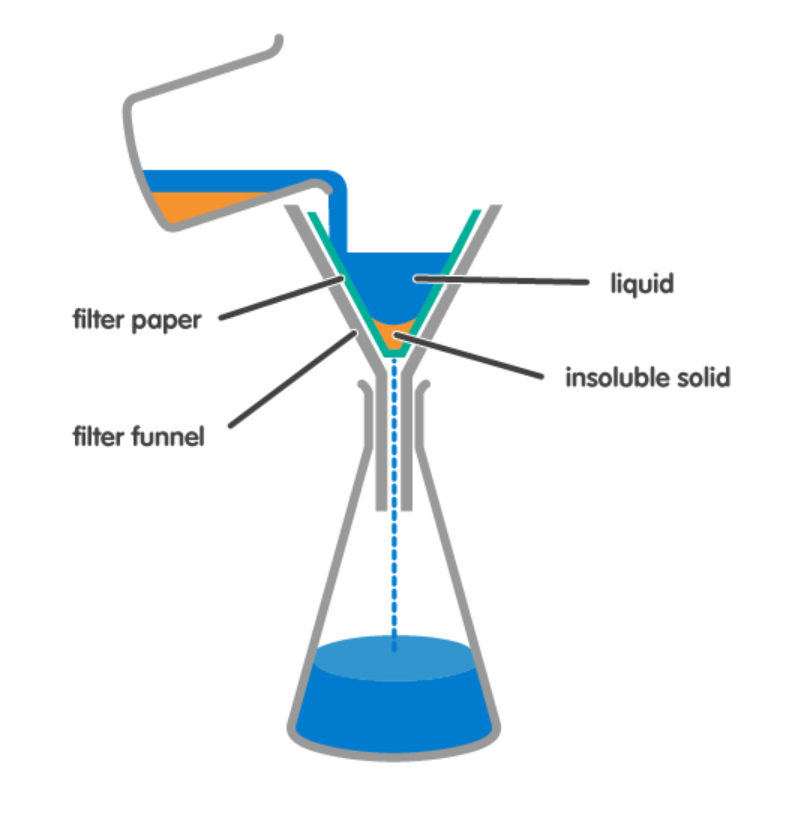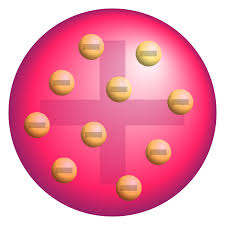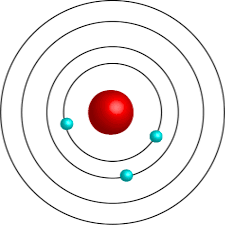Atomic Structure and Periodic Table
1/67
There's no tags or description
Looks like no tags are added yet.
Name | Mastery | Learn | Test | Matching | Spaced |
|---|
No study sessions yet.
68 Terms
Atom
An atom is the smallest part of an element that can exist.
Element
An element is a substance of only one type of atom.
Periodic Table
Table listing all existing elements; there are approximately 100.
What are the two types of elements?
Metals and non-metals.
Compound
Two or more elements chemically bonded.
Properties of Compounds after bonding
They have different properties.
Mixture
Two or more elements or compounds not chemically bonded; it does have the same chemical properties.
Separation Methods for Mixtures
Filtration, crystallisation, simple distillation, fractional distillation and chromatography; they do not involve chemical reactions.

Simple Distillation
Simple distillation is used to separate liquid from a solution.
The liquid boils off and condenses in the condenser
Evaporation
Evaporation is a technique for separation of a solid dissolved in a solvent from a solvent (e.g. salt from H2O).
The solution is heated until all the solvent evaporates; the solids stays in the vessel.
Crystallisation
Crystallisation is the separation of a soluble solid from a solution.
Gently heat solution in an evaporating basin with a bunsen burner/water bath
Solution evaporates
Solid crystals left behind

Fractional Distillation
Fractional distillation is a technique for separation of a liquid in a mixture of liquids. It works when liquids have different boiling points.
Heat mixture of liquids in a flask attavched to fractionating column
Liquid with lowest boiling point evaporates first
It condenses at the top and is collected
After the first liquid id collected, temperature of the column can be increased
Liquid with next highest boiling point to be collected.
Industrial Fractional Distillation
Mixtures are repeatedly condensed and vapourised.

Filtration
Filtration is used to separate an insoluble solid suspended in a liquid.
The insoluble solid (called a residue) gets caught in the filter paper because the particles are too big to fit through the holes in the paper.
The filtrate is the substance that comes through the filter paper.
Chromatography
Chromatography is used to separate a mixture of substances dissolved in a solvent.
6
Plum-Pudding Model - J.J. Thompson
The atom is a ball of positive charge with negative electrons embedded in it.

Nuclear Model - Bohr
The nuclear model suggests that electrons orbit the nucleus at specific distances (shells)
Came about from the alpha scattering experiments.

Protons
Sub-atomic particle with a positive charge; situated in the nucleus.
Neutrons
Sub-atomic particle with no charge; situated in the nucleus
James Chadwick provided evidence for the existence of neutrons in the nucleus
Relative Masses and Charges
(Protons : Neutrons : Electrons)
Masses: 1, 1, very small;
Charges: 1, 0, -1
Neutrality of Atoms
Atoms are electrically neutral because they have the same number of electrons and protons.
Radius of an Atom
0.1 nm.
Atomic Number
The number of protons or electrons in an atom.
Protons in Elements
Atoms of the same element have the same number of protons.
Where is the Majority Mass of an Atom Located?
In the nucleus.
Mass Number
Total number of protons and neutrons in the nucleus.
Calculating number of neutrons
Mass number - Atomic number
Isotope
Atoms of the same element (same proton number) that have a different number of neutrons.
Chemical properties of isotopes
They have the same chemical properties as they have the same electronic structure.
Relative atomic mass
The average mass value which takes the mass and abundance of isotopes of an element into account, on a scale where the mass of carbon (C) is 12.
Max number of electrons per shell - electron configuration
1st shell: 2
2nd shell: 8
3rd shell: 8
4th shell: 2
Ions
Charged particles formed when atoms lose electrons (positive ions) or gain electrons (negative ions).
Example of a positive ion
Sodium
Sodium atom: 11 electrons (atomic number) - Configuration: 2, 8, 1
Sodium ion: New configuration: 2, 8
→ Loses one electron from 3rd shell to have a full 2nd shell: Positive ion
Properties of metals
High boiling/melting point
Conduct heat and electricity
Shiny appearance
malleable
high density
form basic oxides.
Properties of non-metals
Low boiling/melting point
do not conduct heat and electricity (with exception of graphite)
dull appearance
brittle
low density
form acidic oxides.
Ionic bonding
The electrostatic attraction between oppositely charged ions.
Covalent bonding
Shared pair of electrons and the sea of delocalised electrons.
Metallic bonding
The electrostatic attraction between positively charged ions and the sea of delocalised electrons.
Definition of solute
A substance that is dissolved in a solvent.
Definition of solvent
A substance that dissolves a solute to form a solution.
Definition of solution
A mixture formed by dissolving a solute in a solvent.
Definition of soluble
A substance that can be dissolved in a solvent, e.g. salt in water.
Definition of insoluble
A substance that won't dissolve in a particular solvent.
Name of columns of the periodic table + Trend
Groups.
→ Groups show the number of electrons in outer shell
Name for rows of the periodic table + Trend
Periods.
→ Periods show the number of shells in an element
Elements in the same group: Properties
They may have similar chemical properties as they have the same number of outer shell electrons.
Differences between elements of the same period
Differences in energy levels (shells).
Name for Group 0 elements
Noble gases.
Change in shell number going down a group
Number of shells increases as one moves down a group.
Early periodic tables
Early periodic tables were incomplete and elements were placed in inappropriate groups if the strict order of atomic weights was to be followed.
Isotopes in the making of the Periodic table
Knowledge of isotopes made it possible to explain why the order based on atomic weights was not always correct.
Mendeleev's improvements
Mendeleev overcame some problems with the table by:
leaving gaps
changing the order of some elements based on atomic weights.
What type of elements form positive ions?
Metals
What type of elements form negative ions?
Non-metals.
Name for Group 1 elements
Alkali metals.
Characteristics of Alkali Metals
All have one electron in their outer shell (group 1)
have low density
are stored under oil (to prevent reactions with oxygen or water)
are soft (can be cut with a knife).
Group 1 elements and water
Group 1 elements react with water to release hydrogen and form hydroxides which dissolve to form alkaline solutions
They react vigorously with water, fizzing and moving around on the surface.
Reactivity trends in Group 1
Reactivity increases going down the group.
→ As the atoms get larger and the distance and attraction between the nucleus and the outer electrons increases: allowing them to more easily lose electrons.
Characteristics of Group 7 (Halogens)
7 electrons in outer shell
coloured vapours
diatomic molecules (exist as pairs: e.g. oxygen → O2)
form ionic salts with metals
form molecular compounds with non-metals.
Group 7 Elements and States
Fluorine (F): pale yellow gas
Chlorine (Cl): pale green gas
Bromine (Br): dark brown liquid
Iodine (I): grey solid.
Changes in Group 7 Down the Group - Trends
Higher relative molecular mass
higher melting and boiling point
less reactive - less easily gain electrons.
Reactivity Trend of Halogens
Reactivity decreases down the group.
→ As the atoms get larger, incoming electrons less tightly held by the nucleus.
Comparison of Group 1 and Transition Metals
Group 1 metals and transition metals both:
heat and electricity conductors
shiny when polished
form ionic compounds with non-metals.
Transition metals have:
higher densities and higher melting points
are less reactive
harder.
Common Characteristics of Transition Metals
Ions with different charges
coloured compounds
catalytic properties.
Definition of a Catalyst
Chemical substance that increases the rate of a chemical reaction without being used up.
Flame Colors of Lithium, Sodium, and Potassium
Li: Crimson-red
Na: yellow-orange
K: lilac
Properties of Noble Gases (Group 0)
Non-metals
gases
low boiling points
unreactive due to full outer shell; they don't easily accept or lose electrons.
Boiling Point Trend in Noble Gases
The boiling point increases down the group as the atoms get heavier.